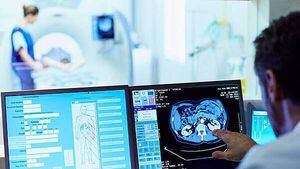Patients overexposed to radiation from CT scans, X-rays and radiotherapy services up 11%

Seán McCárthaigh
The number of patients reported to have experienced overexposure to radiation from diagnostic imaging and radiotherapy services last year rose by almost 11 per cent to 145.
A new report from the Health Information and Quality Authority revealed that it is the highest annual total since HIQA became the competent authority for the regulation of medical exposure to ionising radiation six years ago.
The annual number of cases of overexposure to radiation from medical treatments has now more than doubled since 68 incidents were reported in 2019.
The HIQA report revealed that “human error” was attributed as the main cause of 68 per cent of all significant events reported in 2024.
Under EU regulations, medical bodies are required to notify the health watchdog of significant events where patients and staff are exposed to radiation levels above certain thresholds.
The latest report from HIQA shows the number of notifications relating to an overexposure from diagnostic imaging, which includes X-rays, CT scans, MRIs and ultrasounds, rose by 19% to 129 in 2024 – an annual increase of 21 cases.
However, the annual number of notifications of overexposure to radiation from radiotherapy services decreased from 23 in 2023 to 16 last year.
The report noted that the number of individual hospitals and healthcare providers reporting incidents last year increased from 47 to 59.
Commenting on the figures, HIQA said the increase in reporting levels was “a positive finding” as it indicated increased awareness among healthcare providers of the requirement to report significant events of ionising radiation exposure.
The most common category of incident of reported exposure to radiation arose from CT scans.
They accounted for 68% of all cases reported to HIQA in 2024.
The report showed that 38 incidents resulted in an individual being overexposed to radiation from an incorrect diagnostic imaging procedure.
Another 33 cases arose from an incorrect service user being exposed to radiation in excess of 1 millisievert.
The report showed there were 10 cases last year where an adult received twice the exposure intended or 20 times the dose intended and four cases of a child receiving twice the exposure intended or 15 times the dose intended.
There were also four incidents of inadvertent doses being given to a foetus.
The report said 65% of incidents relating to diagnostic imaging occurred at the point of imaging.
“Many of these incidents were errors, where the correct patient presented with the correct referral information and the correct procedure was requested but the practitioner mistakenly selected the incorrect protocol or body part and completed the procedure,” HIQA stated.
The report also showed that the majority of incidents relating to radiotherapy treatment were due to errors in relation to the dose or volume.
HIQA said a clear pattern to emerge from all incidents reported during 2024 was how many could be pinpointed as “single mistakes made by staff at certain points along the exposure pathway.”
It added: “Many referral and scheduling errors could have been identified at the time of imaging if more attention had been given to fundamental checks.”
HIQA said such checks would have allowed referrers, those who schedule the procedures and practitioners sufficient time to properly verify each radiological procedure.
HIQA said it had developed a poster as a resource to remind staff to double-check some basic information in order to reduce accidental and unintended medical exposure to ionising radiation.
The report said 57 per cent of incidents have resulted in reminders, staff education and information being carried out as “corrective actions” with reminders alone accounting for 31% of cases.
However, HIQA said these types of correction actions were considered “low-level strategies with potentially minimal impact” which were “unlikely to prevent the same type of errors from reoccurring.”
The authority said contributory factors which had been identified were not always appropriately considered or actioned.
“Reminding staff to follow well-established procedures is unlikely to reduce the risk of reoccurrence, without emphasising the consideration of environmental and contributing factors,” HIQA added.
It observed that contributory factors could include staff workload, resources and skill-mix.





